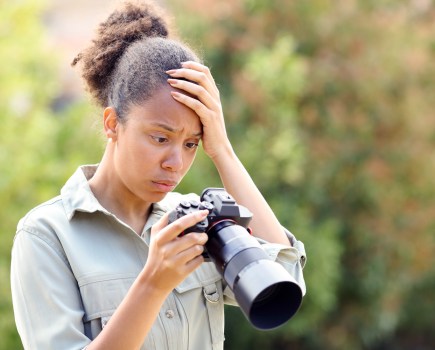One of the great things about photography is that it is such a diverse and personal recreation not everyone shares the same interest in photographing the same subject. If you picked 100 photographers at random and asked them what they enjoyed photographing the most, you’d sure enough get a wide range of answers from the popular to the more obscure. The important thing to remember is that whatever you might have an interest in photographing, it’s imperative that the camera and set-up you use is a fitting match to your chosen subject.
While many of us might aspire to be the owner of a brand new Nikon Z 7 or Sony A7R IV to shoot high-resolution landscape images, or maybe a new Leica if your love lies in street or documentary photography, not all of us have thousands of pounds to buy the latest state-of-the-art cameras. Desirable as they might be, top-of-the-line premium models are beyond the budget constraints of many of us, which can lead to us to look elsewhere or at what might be available on the second-hand market. This got us thinking. Which cameras and lenses can be picked up cheaply for the most popular genres in photography?
First things first, we had to decide on which genres to cover. After agreeing to try to find some bargains for landscape, portraiture, street and sport photography, we began our hunt to see what can be picked up in good second-hand condition for less than £500.
Trawling the second-hand camera market resulted in some interesting finds, some of which might not immediately spring to mind as your first choice. As well as taking different criteria into consideration for each camera such as build quality, features, image quality and how they performed when they were tested, we’ve also made a few alternative suggestions for each genre, including lenses that can be picked up cheaply.
As for where to buy these used bargains from, while you can chance your hand on eBay, there are now some great specialist retailers to try, such as MPB. They will also buy in your old gear, depending on condition, so you can save even more money. Look out for some tips on getting the best price for your old cameras and lenses on here very soon.
Great for landscape photography
Ricoh GR II

At a glance:
- £400
- 16.2MP APS-C CMOS sensor
- 28mm equivalent f/2.8 lens
- ISO 100-25,600
- 4fps continuous shooting
- 3in rear display, 1,230k-dot fixed
- 320 shots battery life
- 251g
- Optional GH-3 accessory kit and GW-3 wide conversion lens available
Landscape photography is typically associated with cameras that boast large sensors and offer extremely high resolution to capture the finest detail in a scene. You might be wondering why it is, then, that the Ricoh GR II has made it onto our shortlist as one of our recommended choices for landscape photographers on a budget. Popular for street photography and situations where you don’t want to attract too much attention to yourself or you wish to blend into the surroundings, the GR II makes a valid choice for travelling and landscape work too. If you’d like full manual control and excellent image quality without the burden of having to lug a heavy camera system mountain high and valley low, it might be the ideal camera you’re looking for.
Some photographers choose it as a small, lightweight, pocket-friendly companion to their DSLR or mirrorless camera, while others rely on it exclusively as their main camera. One of the great things about it is that it’s not too dissimilar to working with a DSLR or mirrorless camera. Okay, its 28mm fixed lens isn’t as versatile as a wideangle zoom, but the buttons and dials across the body fall nicely to hand and it’s very comfortable to hold. The way it can be stashed in a trouser or jacket pocket is one of the main reasons it’s loved so much.
The introduction of the new Ricoh GR III earlier this year has seen the GR II drop in price. Shop around and you’ll be able to find one in excellent used condition for around £400 (just as we did on mpb.com) or even cheaper on eBay. But what can you expect for spending this kind of money? As already mentioned, the GR II features a fixed f/2.8 lens that’s equivalent to 28mm, behind which lies a 16.2-million-pixel, APS-C sized CMOS sensor that delivers detailed and vibrant images when you shoot in raw. It saves raw images as DNG files, meaning they can be opened in virtually any raw-conversion software, and ensures both forward and backwards compatibility with any future software. Like the earlier Ricoh GR, it has a sensitivity range of ISO 100-25,600, features a useful built-in, two-stop, neutral density filter and has a quick one-second- startup/shutdown time. Battery life is rated at 320 shots on a single charge, but if you take advantage of its Wi-Fi connectivity expect to shoot less. Thankfully, Duracell DR9709 replacements for the Ricoh DB-65 battery are neither expensive (£15) nor difficult to source.
As with most cameras, the GR II isn’t without a few pitfalls. Its generous selection of controls might be a bit cramped for some. It has a tendency to overexpose a little, and you need to remove your quick-release tripod plate each time you’d like to access the battery and SD card compartment. Instead of having an adjustable lens ring, it has a removable front ring. Landscape photographers may wish to attach an optional lens hood or use 49mm filters and adapters by purchasing the GH-3 accessory kit (£59). Those who’d like to shoot wider can also buy the 0.75x wide conversion lens (GW-3) that turns it into a 21mm equivalent. A quick search online revealed you can pick up the GH-3 and GW-3 in good used condition for around £160.
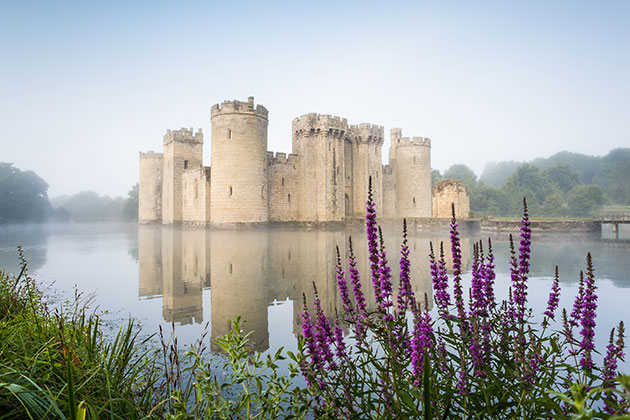
The GW-3 wide conversion lens and GH-3 adapter were fitted to the GR II to capture this scene of Bodiam Castle. Ricoh GR II, 1/30sec at f/4, ISO 100
Handling
The Ricoh GR II’s design is rather utilitarian, with the focus on making it an easy-to-use camera, rather than a stylish or flashy one. The camera consists of a simple black magnesium-alloy body, which keeps the camera fairly light and sturdy, but with no weather-seals it shouldn’t be exposed to wet or sandy conditions. Just to the right of the thumb rest you’ll find plus and minus buttons for immediate control of exposure compensation in shooting mode and zoom in review mode. A jog control switch is also present. This is capable of doing a number of things, such as controlling the ISO sensitivity, plus it can be pushed in to select AF mode, metering mode or change the image style. The level of customisation on the GR II is very good indeed and although the fixed 3in, 1,230k-dot screen isn’t the touch-sensitive type, it has reasonable daylight visibility for when you’re composing images in the great outdoors.
Should I buy it?
The GR II is closely related to its predecessor, the Ricoh GR, but improves in a few areas to make it a better camera, notably the addition of wireless connectivity, better battery life and improved burst depth. If you can’t stretch to the GR II, the original GR (around £275 in good used condition) is a cheaper alternative.
If you have a love for landscapes and fancy a very capable backup compact that takes up minimal space in your backpack, or maybe you like the idea of owning a camera you can tuck in your pocket and achieve fantastic landscape images with when you’re without your DSLR or mirrorless camera, the GR II shouldn’t be overlooked. It’s reliable, offers good value for money, and its preset exposure times of 30sec, 60sec, 120sec, 240sec and 300sec are particularly useful for long-exposure work.
Also consider
Sony A7R

At a glance:
- Price £629 good condition
- Sensor 36.4MP full-frame CMOS
- Sensitivity ISO 50-25,600
- Continuous shooting 4fps
- Video Full HD at 60p
- Rear display 3in, 921k-dot
- Viewfinder 0.5in, 2.36-million-dot EVF
The A7R hit the market at the same time as Sony released the A7 and it became the manufacturer’s first full-frame mirrorless interchangeable-lens cameras to use the E mount. With a high-resolution 36.4MP sensor and 7360×4912 pixel output, it quickly made a name for itself among those who wanted to resolve an astonishing level of detail from a small, light and conveniently sized body. Sony’s line-up of full-frame E-mount lenses has expanded hugely since 2014, and now that it has been superseded by the A7R II, A7R III and A7R IV, the original A7R has become one of the most affordable high-resolution mirrorless cameras you can buy second-hand today.
Tokina AT-X 16-28mm f/2.8 PRO FX
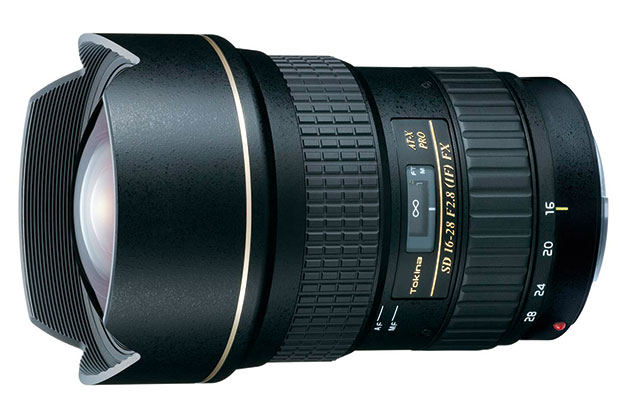
At a glance:
- Price £409 good condition
- Construction 15 elements in 13 groups
- Maximum aperture f/2.8
- Filter thread N/A
- Weight 950g
- Size 90x133mm
Available in Canon and Nikon mounts, this Tokina lens is purpose-made for wideangle moments. It’s a tempting second-hand option for any full-frame users who’d like to squeeze more of their surroundings in the frame and make a hefty saving over big-brand alternatives. Tokina’s exclusive one-touch focus clutch mechanism allows photographers to switch between AF and MF simply by snapping the focus ring forward for AF and back toward the camera to focus manually. It has a built-in lens hood to protect the bulbous front element from knocks and scrapes and as such requires an adapter ring and compatible holder to use it with filters out in the field.
Great for sport & action photography
Nikon D5300 with AF-S DX Nikkor 55-300mm f/4.5-5.6G ED VR
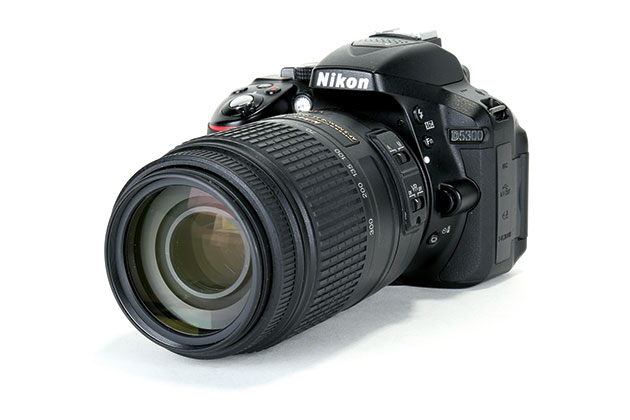
At a glance:
- £443
- 24.2-million-pixel DX-format CMOS sensor
- Nikon F lens mount
- ISO 100-ISO 25,600
- 5fps continuous shooting
- Full HD video at 60p
- 3.2in rear display, 1,037k-dot vari-angle screen
- 600 shots battery life
- 480g (body only)
If you’re just starting out in photography, or maybe feel your current camera isn’t the best equipped for shooting sports and action, there are so many options on the second-hand market you’ll find you’re rather spoilt for choice. Over the years we’ve seen many fine-performing DSLRs drop substantially in price – the original Canon EOS 7D being one example. When it was launched 10 years ago it would set you back £1,699 for the body alone. Today it can be picked up for as little as £289 through second-hand specialists like mpb.com in ‘like new’ condition with a shutter count of only 6,000 shots. While it’s relatively easy to find great used cameras or suitable second-hand lenses for action and sports photography under £500, buying both on this budget requires you to search a bit harder. Provided you’re willing to compromise a little on speed, you will be able to find an excellent example of a DSLR and a telephoto lens that gets you right to the heart of the action, just as we did with the Nikon D5300 (£279 in excellent condition) and AF-S DX Nikkor 55-300mm f/4.5-5.6G ED VR (£164 in excellent condition).
The Nikon D5300 isn’t best known for its high-speed shooting, but provides more than sufficient resolution from its 24.2-million-pixel APS-C CMOS sensor and can rattle out a continuous burst at 4fps when shooting 14-bit raw files and 5fps when shooting JPEGs or 12-bit raw files. This might sound a bit pedestrian compared to many of today’s DSLRs and mirrorless cameras that can shoot at lightning speeds of 20fps and faster; however if you’ve got a good shooting technique and have more than one opportunity to get a perfectly timed shot, there’s nothing to stop you getting great results with it. Buffer depth and autofocus speed are hugely important when you want to shoot fast-moving or erratic subjects. In the case of the D5300 it manages to shoot 13 continuous raw images (12-bit) at 5fps before it requires a breather. This, like its burst speed, shows the D5300’s age, but if you switch from shooting in raw to fine JPEG you can capture up to 100 frames at 5fps without interruption. There are plenty of cameras capable of shooting faster for longer duration, but you’ll find these require a premium to be paid for their faster internal memory, which allows more image data to be written in a shorter time.
So what about autofocus? The D5300 uses Nikon’s Multi-Cam 4800DX autofocus module that provides 39 selectable focus points, nine of which are the faster and more reliable cross-type. You get an excellent selection of AF-area modes too, including single-point AF; 9-, 21- or 39-point dynamic-area AF; and 3D-tracking. Its focus speed isn’t a match for newer and high-end DX-format Nikon DSLRs like the D500, but you’ll find that it takes just a fraction of a second to lock on, even in fading light. As for the performance of the lens, it doesn’t have the same immediacy as tele-zooms that cost thousands of pounds when asked to focus from near to far or vice versa. But with the crop factor considered, its effective 82.5-450mm focal length lets you ll the frame with distant subjects, thus reducing the amount of cropping required in post-processing and maximising high levels of detail.

It may only shoot at up to 5fps, but decisive moments can be captured with the D5300. Nikon D5300, 1/800sec at f/6.3, ISO 800
Handling
While its predecessor had a polycarbonate exoskeleton that was based around a metal chassis, the D5300 body is a ‘monocoque’ design. This involves using a single shell made of carbon-fibre-reinforced plastic without the metal chassis, which cuts down on weight while maintaining durability. As a result, the D5300 weighs just 480g, which combined with the 55-300mm lens (580g), makes it a lightweight combination for sports and action photography.
The handgrip isn’t huge. Those who have big hands may find their little finger falls off the bottom, but for those with small or average-sized hands it offers a good depth to wrap your palm around it to get a solid hold. Your thumb easily finds the button marked ‘i’, which loads the shooting menu from where many important settings can be changed. With no front dial, users are forced to hold the exposure compensation button and tweak the rear dial to adjust aperture in manual mode.
Should I buy it?
It might be an advanced entry-level DSLR that’s getting on for being six years old, but the Nikon D5300 remains a very good camera with the potential to produce fantastically detailed images from its sensor, which excludes an anti-aliasing filter. Faster cameras and lenses are available if you have a need for top-level performance in low light, but you can expect these to fetch much higher prices.
To sum up, this combination gives anyone who has an interest in taking sports or action photography more seriously the opportunity to do so, and produces far superior results to those you’d take using a basic compact or smartphone. Add its 600-shot battery stamina, excellent articulated screen and intuitive handling to the mix, and for £443, it makes a great budget buy.
Also consider
Canon EOS 7D
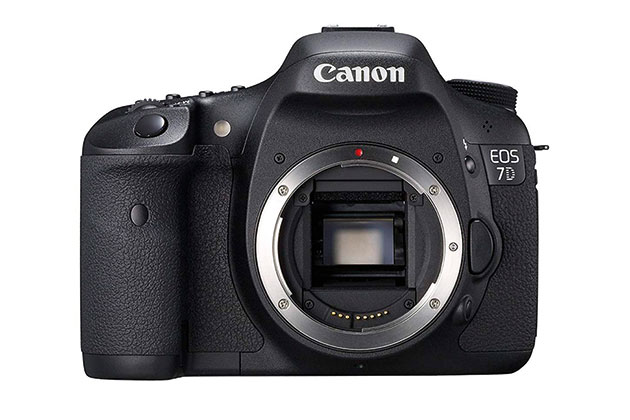
At a glance:
- Price £274 excellent condition
- Sensor 18MP APS-C CMOS
- Sensitivity ISO 100-6400 (expandable to ISO 12,800)
- Continuous shooting 8fps
- Video Full HD at 30fps
- Rear display 3in, 921k-dot
- Viewfinder Optical (100% coverage)
Back in September 2009, Canon launched its flagship APS-C DSLR: the EOS 7D. Built around an 18MP APS-C sensor and two DIGIC 4 image processors, the EOS 7D combines a 19-point, all cross-type AF system with continuous shooting at up to 8fps. Initially, the buffer withstood 94 frames in large Fine JPEG mode, and up to 15 frames in raw, but a firmware update did eventually see this number increase to 130 large Fine JPEGs and 25 raw files. It can’t compete with today’s finest sports cameras when it comes to high-speed shooting, but it remains a solid workhorse and a great option if you’d like a dependable, low-cost, weather-sealed DSLR.
Sigma APO 150-500mm F5-6.3 DG OS HSM
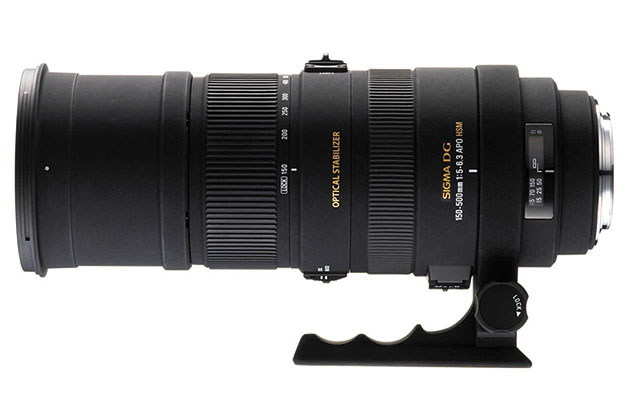
At a glance:
- Price £369 excellent condition
- Construction 21 elements in 15 groups
- Maximum aperture f/5-f/6.3
- Filter thread 86mm
- Weight 1,780g
- Size 94.7x252mm
The introduction of Sigma’s 150-600mm F5-6.3 DG OS HSM Contemporary lens has seen older Sigma lenses of similar focal lengths drop substantially in price. One such example is the Sigma APO 150-500mm F5-6.3 DG OS HSM, which at £369 in excellent condition presents an affordable way of getting up close to subjects when you might have restricted access. It doesn’t have the same reach as some of Sigma’s latest telezooms in its Contemporary and Art line-ups; nevertheless it features optical stabilisation and is a far better option than making do with your standard kit lens. Couple it to an APS-C DSLR like the Nikon D5300 and it turns into a whopping 225-900mm equivalent.
Great for street photography
Fujifilm X100S
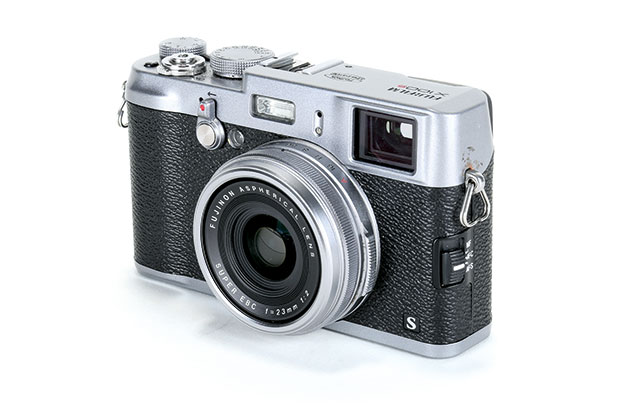
At a glance:
- £444
- 16.3MP APS-C X-Trans CMOS II sensor
- 35mm equivalent f/2 lens
- ISO 100-25,600
- 6fps continuous shooting
- Hybrid viewfinder
- 2.8in, 460k-dot fixed LCD
- 330 shots battery life
- 445g
While it’s possible to engage in street photography with almost any kind of camera, most experienced practitioners favour small, discreet bodies with fast prime lenses in the 35-50mm range. Pre-digital, photographers generally preferred range finder cameras for the job, and these days a small mirrorless model will do nicely. However if you can live with a fixed lens, the Fujifilm X100S is an excellent choice for exploring this genre.
As the second model in Fujifilm’s line of rangefinder-like APS-C compacts, the X100S is a classically styled camera with traditional analogue controls for shutter speed, aperture and exposure compensation, which make it extremely engaging to shoot with. Its old-fashioned good looks mean that out on the street, your subjects will often assume you’re using a film camera, and perhaps be more relaxed as a result. For photographers who value a stealthier look, a black version was produced, but it’s hard to find second-hand.
Its striking looks, however, belie the X100S’s considerable photographic abilities. Its 16-million-pixel sensor provides a standard sensitivity range of ISO 200-6400, and uses Fujifilm’s signature X-Trans design that eliminates the need for a resolution-sapping optical low-pass filter. In concert with the 23mm f/2 lens (equivalent to a 35mm optic on full frame), it delivers fine image quality even in low-light conditions. If you wish, you can even shoot at 6fps to help capture the perfect moment.
However it’s the unique hybrid viewfinder that really stands out. This allows you to switch between a direct-vision optical viewfinder and a 2.36-million-dot electronic display, simply by flicking a switch on the camera’s front. What’s more, the EVF can be used to superimpose a whole range of shooting information on the optical finder. The only other place you’ll find this is on Fujifilm’s X-Pro mirrorless cameras. It’s the real-time experience of using an optical finder, and the fact that you can see what’s happening slightly beyond the image area to anticipate how the scene might develop, that endears the X100 range to a lot of street shooters. Of course you can use the LCD on the back for composition too, but it’s fixed, low resolution and not touch sensitive.
Another standout attraction of the X100 series has always been the out-of-camera JPEG quality. The X100S benefits from Fujifilm’s peerless colour reproduction, via its Film Simulation modes based on classic emulsions. For monochrome lovers, a range of modes simulate black & white film used with different colour filters, all previewed live in the EVF. In-camera raw conversion is available for experimenting with your shots after the event.
So what are the drawbacks? Like all X100 models, autofocus isn’t particularly quick, and while face detection is on board, you won’t get modern innovations such as eye-tracking continuous AF. The controls aren’t quite as slick as later X100 generations, either, with an aperture ring that clicks in whole-stop increments, and slightly awkward focus-area selection. As usual for a camera of this vintage there’s no built-in Wi-Fi; for that, you need one of the later models.
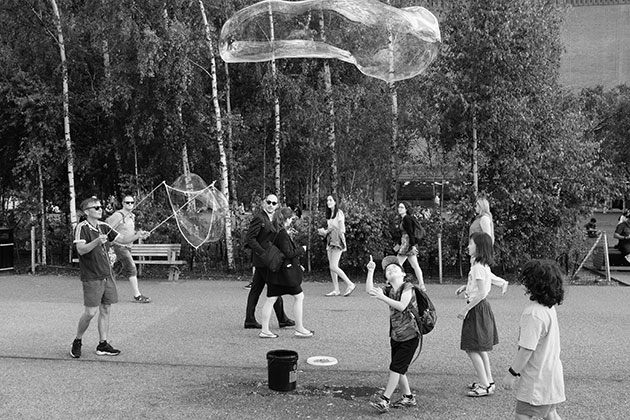
With its small size and near-silent shutter, the X100S won’t distract your subjects. 1/260sec at f/5.6, ISO 400
The generation game
Fujifilm’s X100 series is one of the few digital camera lines that will be counted as outright classics in future. The original X100, released in 2011, initiated a change in the company’s direction from making mass-market compacts to producing cameras for serious photographers. It laid down the template for using an APS-C sensor together with a 23mm f/2 lens in a rangefinder-like body, but unlike its successors, it employed a conventional Bayer sensor with 12MP resolution. However an underpowered processor means it’s painfully slow by modern standards, and arguably now better seen as a collector’s piece.
In 2013 the X100S added a new 16MP X-Trans sensor and X-Processor Pro, considerably improving the camera’s performance. It also tweaked the button layout to make certain functions easier to use. Less than two years later, the X100T used the same sensor and processor but gained much-improved controls and an updated viewfinder, making for a more satisfying user experience. Readily available in both silver and black, expect to pay £500-600 for a good used example. The current model is the 2017 X100F, which benefits from a 24MP sensor, faster processor, beefier battery and AF-point joystick. It’ll set you back around £1,200 new, or £900 in like-new used condition.
Should I buy it?
If you fancy channelling your inner Henri Cartier-Bresson but don’t want to venture out onto the streets with a large, intrusive DSLR, then the X100S is well worth a look. It’s not the quickest or easiest-to-use camera in the series, but it’s only surpassed in terms of image quality by the much more expensive X100F. The sluggish autofocus means you may have to perfect classic street-photography techniques such as pre-focusing or zone focusing, but stick with it and the camera is capable of delivering fine images. Those with a bit more money to spare, however, should certainly consider the X100T as well.
Also consider
Fujifilm X70

At a glance:
- Price £469 excellent condition
- Sensor 16.3MP APS-C X-Trans CMOS II
- Lens 28mm equivalent f/2.8
- Continuous shooting 8fps
- Rear display 3in, 1.04-million-dot fixed LCD
- Battery life 330 shots
For a slightly different take on street photography, the X70 is closely related to the X100T, with a similar 16.3MP sensor and analogue control layout but a wider-angle 28mm equivalent lens. However it loses the hybrid viewfinder, instead gaining a tilting rear screen that can be used at waist level for discreet shooting. These changes result in a smaller, slimmer body that’s easier to slip into a coat or jacket pocket. In excellent condition the X70 is likely to cost around £470, which actually makes it pricier than its notional successor in Fujifilm’s line-up, the 24MP Bayer-sensor XF10. But the latter loses the analogue controls and only has a fixed screen.
Panasonic Lumix GX80

At a glance:
- Price £239 excellent condition
- Sensor 16MP Four Thirds MOS
- Lens mount Micro Four Thirds
- Continuous shooting 8fps
- Rear display 3in, 1.04-million-dot tilting LCD
- Battery life 290 shots
Not everyone is happy shooting with a fixed prime lens, and if you’d rather expand your optical horizons, a compact mirrorless body is the obvious answer. The Lumix GX80 is a rangefinder-style camera that’s small enough to slip into a coat pocket, but which performs well and boasts a decent feature set including a tilting touchscreen and a corner-mounted viewfinder. Pair it with the tiny 12-32mm f/3.5-5.6 zoom, and you should still have change from £500 to add a fast prime such as Panasonic’s 25mm f/1.7 or 20mm f/1.7 pancake.
Great for portrait photography
Olympus OM-D E-M10 with 45mm f/1.8 lens

At a glance:
- £340
- 16MP Four Thirds MOS sensor
- Micro Four Thirds lens mount
- ISO 200-25,600
- 8fps continuous shooting
- Full HD video at 30fps
- 3in rear display, 1.04-million-dot tilting LCD
- 320 shots battery life
- 396g
With portraits it’s all about the optics, and that’s where we’ve started here. The Olympus M.Zuiko Digital 45mm f/1.8 is quite simply one of our favourite budget short-telephoto portrait lenses. It’s small, lightweight, sharp wide open (but not too sharp), and gives attractive background blur. Crucially it’s also very affordable; used examples sell for as little as £159 in excellent condition on mpb.com.
Let’s take a closer look at what makes this lens such a fine option. First, it offers a focal length equivalent to 90mm on full frame, which enables a more flattering perspective for head-and-shoulders portraits than the inexpensive 50mm f/1.8 lenses that are commonly used for this purpose on APS-C DSLRs. The f/1.8 aperture allows you to shoot indoors in relatively low levels of natural light without having to raise the ISO too far, and delivers a decent degree of background blur. Because it’s being used on the smaller Micro Four Thirds sensor, it’s not the same in this respect as using an f/1.8 prime on full frame, or even APS-C: instead this lens gives the same pictorial effect in terms of background blur as a 60mm f/2.2 on APS-C, or a 90mm f/3.5 on full frame. But few lenses with this kind of specification exist for these larger format systems, and even those that do are considerably more expensive.
Equally important for portrait shooting is the fast, silent and consistently accurate autofocus. It’s easy to forget that Olympus cameras have long featured face- and eye-detection AF that work effectively in single AF mode with static subjects, since well before Sony expanded and popularised its own Eye AF function. So you shouldn’t have too much difficulty getting your subject’s eyes sharp. The minimum focus distance of 0.5m allows for striking close-ups.
The 45mm f/1.8 is also tiny, measuring just 46mm long and tipping the scales at a featherweight 116g. It’s truly a lens that you can carry around all day as an accompaniment to a kit zoom, and barely notice. It’s not flawless, though, and are can be a serious problem when you’re shooting into the light, destroying contrast. So it’s advisable to acquire a lens hood, which fits onto a bayonet mount that’s normally hidden by a cosmetic ring at the front of the barrel.

This combination delivered some great shots on a vintage portrait shootwith TimeLine Events. Olympus OM-D E-M10, 45mm, 1/800sec at f/1.8, ISO 200
A retro classic
A lens is no good without a camera to use it on, of course, and we’ve chosen the first generation of Olympus’s lovely retro-styled OM-D E-M10 line. This 2014 model brought most of the best bits of the hugely popular OM-D E-M5 into a more affordable body, which lacked the weather-sealing of its sibling but gained a built-in flash that’s handy for providing a little fill-in for portraits. It costs as little as £179 used, so all together, you can buy a nice portrait kit for a mere £340. If you want a better-designed body with mod cons such as Wi-Fi, the E-M10 Mark II is about £75 more.
Olympus’s little retro-styled OM-D cameras also bring their own charms. For portraits, chances are your subjects will find them far less intimidating than a big DSLR. You can use the tilting rear screen as a low-level finder, allowing you to engage with your subjects without the camera getting in the way. If you prefer, you can of course use the central electronic viewfinder, and while the E-M10’s 1.44-million-dot EVF lacks resolution by current standards, it’s still perfectly usable.
You also get the benefits of Olympus’s attractive JPEG processing. The firm is known for the warm and relatively punchy colour rendition of its default Natural mode, while switching to the Portrait profile will give a slightly gentler look. Many users find the noise filtering over-aggressive for most subjects, but with portraits it does have the effect of smoothing away unwanted skin detail.
Other attractions of the E-M10 include relatively quiet operation, although it lacks the super-soft shutter of later generations. Its 3-axis in-body image stabilisation also helps you to get sharper images with any lens, including unstabilised fast primes like the 45mm f/1.8. Just be aware that when photographing people you’ll generally need to select relatively fast shutter speeds anyway, to counteract subject movement.
Should I buy it?
If you’re already a Micro Four Thirds user but don’t own the Olympus 45mm f/1.7 (or the similar Panasonic 42.5mm f/1.7 OIS), then stop reading right now and get one. It’s a fabulous little lens and I doubt many photographers would regret buying it. Otherwise, if you’re interested in trying a small and unobtrusive combination for photographing people, then it’s difficult to think of a better combination than pairing this gem of a lens with a small Micro Four Thirds body like the Olympus OM-D E-M10.
Also consider
Tamron SP 60mm F/2 Di II LD Macro

At a glance:
- Price £239 like new condition
- Aperture range f/2-f/22
- Filter thread 55mm
- Diameter 73mm
- Length 80mm
- Weight 350g
It’s easy, when recommending relatively inexpensive portrait lenses, to point towards camera manufacturers’ 50mm f/1.8 and 85mm f/1.8 primes, and forget everything else. But for users of APS-C DSLRs, this unusually large-aperture macro lens from Tamron is also well worth a look. As part of the firm’s SP range it promises premium optics, while the 90mm equivalent view provides a flattering perspective for head-and-shoulders portraits. Best of all, when you’ve had enough of photographing people, it also offers life-size magnification for close-ups. It’s available in Canon EF, Nikon F and Sony Alpha mounts.
Canon PowerShot G7 X Mark II
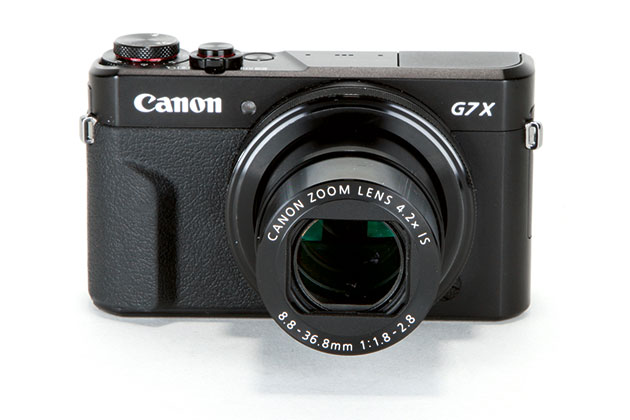
At a glance:
- Price £379 excellent condition
- Sensor 20.1MP 1in type CMOS
- Lens 24-100mm equivalent f/1.8-2.8
- Continuous shooting 8fps
- Rear display 3in, 1.04-million-dot tilting touchscreen
- Battery life 240 shots
This may look like a left-field recommendation, but if you want a pocketable compact camera for shooting people pictures on social occasions, it’s very worthy of consideration thanks to its relatively long, large-aperture zoom. Viewing is via a tilting touchscreen, which means you can maintain eye contact with your subject and set the focus point quickly by touch. At its telephoto position the lens can blur backgrounds more effectively than the kit zooms typically supplied with APS-C and Micro Four Thirds cameras, and will handily outperform any smartphone. The first-generation G7 X is cheaper, at around £309, but somewhat slower in operation.
Note: The price and availability of the products mentioned in this article were correct at the time of writing, but may be subject to change at any time.






